NCERT Solutions for Chapter 10 Light-Reflection and Refraction Class 10 Science
Book Solutions1
Answer
Light rays that are parallel to the principal axis of a concave mirror converge at a specific point on its principal axis after reflecting from the mirror. This point is known as the principal focus of the concave mirror.2
Answer
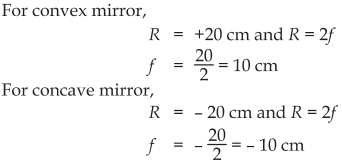
Hence, the focal length of the given spherical mirror is 10 cm.
3
Answer
Concave Mirror4
Answer
We prefer a convex mirror as a rear-view mirror in vehicles because it gives a wider field of view, which allows the driver to see most of the traffic behind him. Convex mirrors always form a virtual, erect, and diminished image of the objects placed in front of it.1
Answer
Radius of curvature = 2 × Focal length (f)
R = 2f
⇒ f = R/2
⇒ f = 32/2 = 16 cm
Hence, the focal length of the given convex mirror is 16 cm.
2
Answer
Magnification produced by a spherical mirror is given by the relation,

m = -3
u = -10 cm [Object distance is always negative]
m = -v/u
⇒ v = -mu
⇒ v = -(-3 × -10) cm
⇒ v = -30 cm
Here, negative sign indicates that an inverted image is formed in front of the mirror. Thus, real image is formed at a distance of 30 cm in front of the mirror i.e. on the same side as the object.
1
Answer
The ray of light bends towards the normal. When a ray of light enters from an optically rarer medium (having low refractive index) to an optically denser medium (having high refractive index), its speed slows down and it bends towards the normal. Since water is optically denser than air, a ray of light entering from air into water will bend towards the normal2
Answer
Refractive index of a medium, nm = Speed of light in vacuum/Speed of light in the medium
Speed of light in vacuum, c = 3 × 108 ms-1
Refractive index of glass, ng = 1.50
Speed of light in the glass, v = c/ng
=3 × 108/1.50
= 2 × 108 ms-1.
3
Find out, from Table, the medium having highest optical density. Also find the medium with lowest optical density.
|
Material medium |
Refractive index |
Material medium |
Refractive index |
|
Air |
1.0003 |
Canada Balsam |
1.53 |
|
Ice |
1.31 |
- |
- |
|
Water |
1.33 |
Rock salt |
1.54 |
|
Alcohol |
1.36 |
- |
- |
|
Kerosene |
1.44 |
Carbon disulphide |
1.63 |
|
Fused quartz |
1.46 |
Dense flint glass |
1.65 |
|
Turpentine oil |
1.47 |
Ruby |
1.71 |
|
Benzene |
1.50 |
Sapphire |
1.77 |
|
Crown glass |
1.52 |
Diamond |
2.42 |
Answer
Highest optical density = DiamondLowest optical density = Air
Optical density of a medium is directly related with the refractive index of that medium. A medium which has the highest refractive index will have the highest optical density and vice-versa.
It can be observed from table 10.3 that diamond and air respectively have the highest and lowest refractive index. Therefore, diamond has the highest optical density and air has the lowest optical
density.
4
You are given kerosene, turpentine and water. In which of these does the light travel fastest?
Use the information given in Table.
|
Material Medium |
Refractive Index |
|
Air |
1.0003 |
|
Canada Balsam |
1.53 |
|
Ice |
1.31 |
|
Water |
1.33 |
|
Rock salt |
1.54 |
|
Alcohol |
1.36 |
|
Kerosene |
1.44 |
|
Carbon disulphide |
1.63 |
|
Fused quartz |
1.46 |
|
Dense flint glass |
1.65 |
|
Turpentine oil |
1.47 |
|
Ruby |
1.71 |
|
Benzene |
1.50 |
|
Sapphire |
1.77 |
|
Crown glass |
1.52 |
|
Diamond |
2.42 |
Answer
In water light travel faster as compare to kerosene and turpentine because the refractive index of water is lower than that of kerosene and turpentine. The speed of light is inversely proportional to the refractive index.5
Answer
The refractive index of diamond is 2.42. This means that the speed of light in diamond will reduce by a factor of 2.42 as compared to its speed in air.In other words, the speed of light in diamond is 1/2.42 times the speed of light in vacuum.
1
Answer
The SI unit of power of lens is dioptre which is denoted by the letter D. 1 dioptre is defined as the power of a lens of focal length 1 metre.2
Answer
Since the image is real and same size. The position of image should be at 2F.
It is given that the image of the needle is formed at a distance of 50 cm from the convex lens. Hence, the needle is placed in front of the lens at a distance of 50 cm.
Object distance, u= - 50 cm
Image distance, v= 50 cm
Focal length = f
According to the lens formula,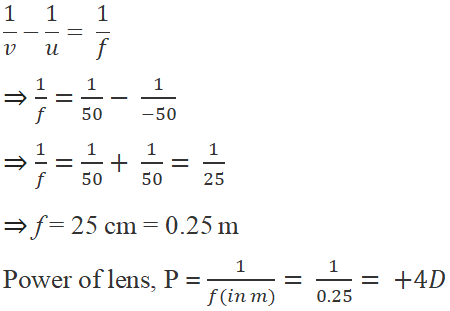
Thus, the power of lens is 4 Dioptre.
3
Answer
Focal length of concave lens,
f = 2 m
Power of lens, P= 1/f
= 1/(-2)
= -0.5 D
1
(a) Water
(b) Glass
(c) Plastic
(d) Clay
Answer
(d) Clay2
(a) Between the principal focus and the centre of curvature
(b) At the centre of curvature
(c) Beyond the centre of curvature
(d) Between the pole of the mirror and its principal focus.
Answer
(d) Between the pole of the mirror and its principal focus.3
(a) At the principal focus of the lens
(b) At twice the focal length
(c) At infinity
(d) Between the optical centre of the lens and its principal focus.
Answer
(b) At twice the focal length4
(a) both concave
(b) both convex
(c) the mirror is concave and the lens is convex
(d) the mirror is convex, but the lens is concave
Answer
(a) both concave5
(a) plane
(b) concave
(c) convex
(d) either plane or convex
Answer
(d) either plane or convex6
(a) A convex lens of focal length 50 cm
(b) A concave lens of focal length 50 cm
(c) A convex lens of focal length 5 cm
(d) A concave lens of focal length 5 cm
Answer
(c) A convex lens of focal length 5 cm7
Answer
Range of the distance of the object = 0 to 15 cm from the pole of the mirror.Nature of the image = virtual, erect and larger than the object.
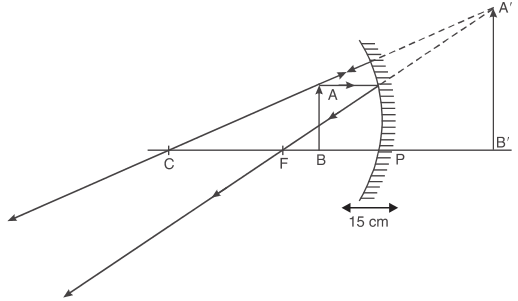
8
(a) Headlights of a car
(b) Side/rear-view mirror of a vehicle
(c) Solar furnace
Support your answer with reason.
Answer
(a) Concave Mirror: This is because concave mirrors can produce powerful parallel beam of light when the light source is placed at their principal focus.
(b) Convex Mirror: This is because of its largest field of view.
(c) Concave Mirror: This is because it concentrates the parallel rays of sun at principal focus.
9
Answer
The convex lens will form complete image of an object, even if its one half is covered with black paper. It can be understood by the following two cases.
Case I :When the upper half of the lens is covered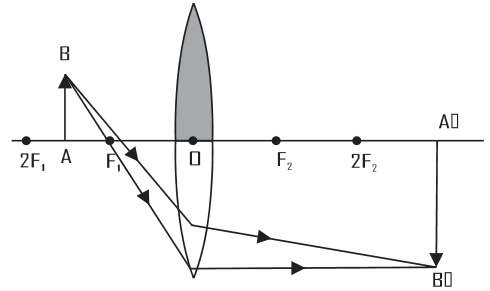
In this case, a ray of light coming from the object will be refracted by the lower half of the lens. These rays meet at the other side of the lens to form the image of the given object, as shown in the above figure.
Case II: When the lower half of the lens is covered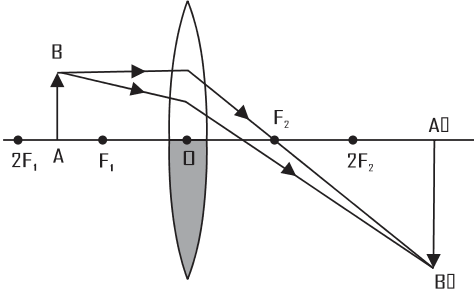
In this case, a ray of light coming from the object is refracted by the upper half of the lens. These rays meet at the other side of the lens to form the image of the given object, as shown in the above figure.
10
An object 5 cm in length is held 25 cm away from a converging lens of focal length 10 cm. Draw the ray diagram and find the position, size and the nature of the image formed.
Answer
Height of object (h) = 5 cm
Height of image (h’) = ?
Distance of object (u) = -25 cm
Distance of image (v) = ?
Focal length (f) = +10 cm
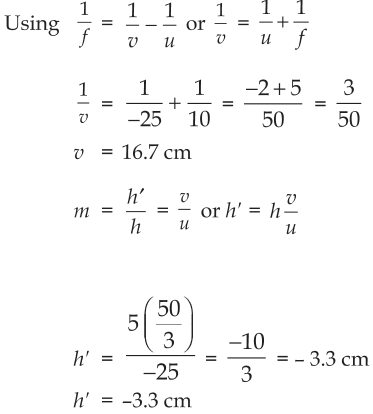
Here, the negative sign means the image is inverted. Image is formed at a distance of 16.7 cm behind the lens and measures 3.3 cm. The ray diagram is: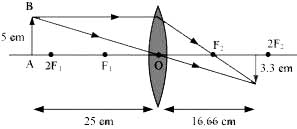
11
A concave lens of focal length 15 cm forms an image 10 cm from the lens. How far is the object placed from the lens? Draw the ray diagram.
Answer
Focal length of concave lens (OF1), f = - 15 cm
Image distance, v= - 10 cm
According to the lens formula,
The negative value of u indicates that the object is placed 30 cm in front of the lens. This is shown in the following ray diagram.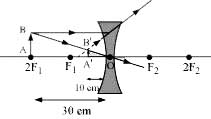
12
Answer
Focal length of convex mirror, f= +15 cm
Object distance, u= - 10 cm
According to the mirror formula,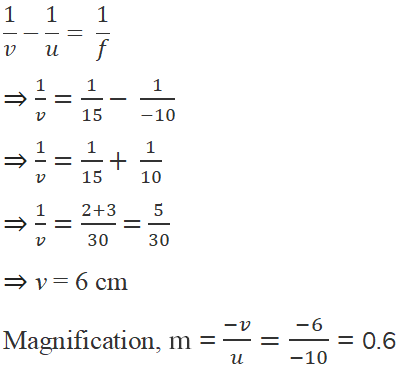
The image is located at a distance 6 cm from the mirror on the other side of the mirror.
The positive and value less than 1 of magnification indicates that the image formed is virtual and erect and diminished.
13
Answer
The positive sign means image formed by a plane mirror is virtual and erect. Since the magnification is 1 it means that the size of the image is equal to the size of the object.14
Answer
Object height, h= 5 cm
Radius of curvature, R= 30 cm
Radius of curvature = 2 × Focal length
R= 2f
f= 15 cm
According to the mirror formula,

Positive value of v indicates that image is formed behind the mirror.
Magnification, m = -v/u
= -8.56/-20 = 0.428
The positive value of magnification indicates that image formed is virtual.
Also, magnification (m) = height of image/height of object
⇒ m = h'/h
⇒ h' = m×h
⇒ h' = 0.428×5 = 2.14 cm
The positive value of image height indicates that the image formed is erect.
Therefore, the image formed is virtual, erect, and smaller in size.
15
Answer
Object distance, u= - 27 cm
Object height, h= 7 cm
Focal length, f = - 18 cm
According to the mirror formula,
The screen should be placed at a distance of 54 cm in front of the mirror.
Magnification, m = -v/u
= -54/27 = -2
The negative value of magnification indicates that image formed is real.
Also, magnification (m) = height of image/height of object
⇒ m = h'/h
⇒ h' = m×h
⇒ h' = 7×-2 = 14 cm
The negative value of image height indicates that the image formed is inverted.
16
Answer
Power of lens, P = 1/f (in m)P = -2D
f = -1/2 = -0.5 m
A concave lens has a negative focal length. Hence, it is a concave lens.
17
Answer
Power of lens, P= 1/fP= 1.5D
f= 1/1.5 = 10/15 = 0.66 m
A convex lens has a positive focal length. Hence, it is a convex lens or a converging lens.